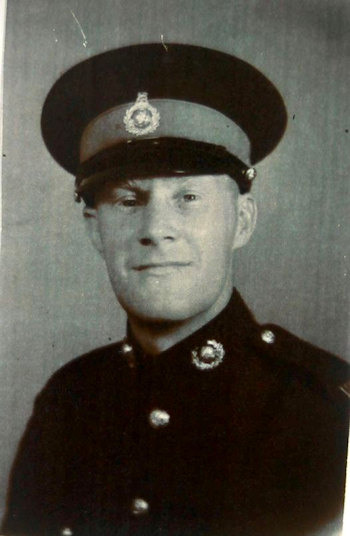 Lewis Straughan grew up between Pocklington and Barmby Moor, where his family manned a railway crossing. He married Peggy England, from Warter, and spent his whole working life as a printer at Dobson & Co on Barmby Road, living round the corner on George Street.
Lewis Straughan grew up between Pocklington and Barmby Moor, where his family manned a railway crossing. He married Peggy England, from Warter, and spent his whole working life as a printer at Dobson & Co on Barmby Road, living round the corner on George Street.
But at the outbreak of war in 1939 he was called up and drafted into the Royal Marines. Ironically he spent almost five years training and on manoeuvres without seeing action; then selected for the first wave of troops for the D-Day invasion, his war lasted only a few minutes before he was seriously wounded – one of over 10,000 allied troops killed or wounded that day on the beaches of Normandy.
But his war-time memoirs of the events of 6 June 1944 give a picture of the enormity and horrors of the events that were the turning point of World War II.
After intensive training in England, Wales, then time served overseas in South Africa, Egypt, Libya and Sicily without firing a shot in anger, Lewis and his Royal Marine comrades finally arrived back in Scotland in 1943, where he volunteered for Commando training.
Months of further intensive exercises followed in the Scottish lochs, forests and mountains, often with live ammunition, before being sent to the south coast.
Placed in a 15-foot barbed-wire compound, all contact with the outside world ceased as planning began for the re-invasion of France; with a whole day spent examining a detailed model of the French coast, learning the terrain where the unit would land.
Lewis takes up his story of June 1944:
“The day before D-Day we all gathered together and sang ‘Abide With Me’ and the naval hymn ‘For those in peril on the sea’, for quite a number the last they ever sang.
We then marched down to the docks, before boarding our landing craft we passed tables loaded with ‘ammo’ and grenades. As a sniper I had special ammo including tracer bullets and a wonderful rifle fitted with telescopic sights, but we could take anything we liked off any of the tables, especially the grenades. We were all given ampules of morphine with a needle for self-injection, and all also had to carry a 3-inch mortar bomb.
We boarded our landing craft about 5.30pm on June 4, but when all was ready the landing was called off for 24-hours owing to bad weather. We disembarked and tried to sleep in a nearby field until the following day, once again embarking ready for the landing on June 6 1944.
Arrived off the French coast before dawn after a very stormy crossing. As it grew lighter there were ships of all shapes and sizes as far as the eye could see. The huge battleships line abreast and at a given time opened up with all their guns, I can’t describe the terrific noise. We circled behind the battleships till the guns were silent, then we turned and raced for the shore.
We landed at Arromanches (Gold Beach), many ships were hit, the Commando next to me on the craft gave a grunt, a bullet had hit him between the eyes and his brains splattered all over my pack.
Many landing craft had barrage balloons fixed to the stern to stop enemy aircraft, our craft was hit and we scrambled over many bodies to get over the ramp and onto the beach. We raced for the sea-wall and up and over the top when I was clobbered with a shell through my thigh and crashed back onto the beach.
I used my morphine ampule, and a naval surgeon later gave me further injections, finally with many others I was collected by jeep and taken to a field hospital. Too complicated to operate in the field, I was bundled on a stretcher, put on board a DUWK amphibious vehicle, machine gunned and hit again in the same leg then managed to board a huge tank landing craft, given further injections, and landed back at Southampton.”
Lewis’ war was over almost as soon as it begain. Operations and skin grafts followed, and it was a year before he was able to return home to Pocklington. His part in D-Day had lasted just a few minutes, he was one of over 10,000 allied troops killed or wounded in the first day assault. But the heroic efforts of the first wave troops enabled the allies to knock out the heavy German beach head defences, and the re-invasion was underway that went on to victory and end the war.
Still handicapped by his injuries, Lewis went back to work at Dobson’s, where he worked for another 40 years, and lived in George Street until his death in 2001 aged 84. He may have been an elite soldier, and was a proud member of Royal Marine Commando Association, but he was the mildest of men, who was noted for decades for bell ringing at Pocklington church, and for his wildlife illustrations and extensive stamp collection.

